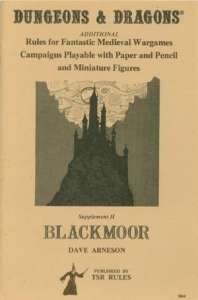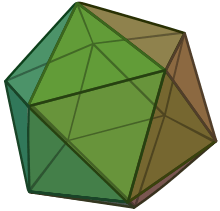Blackmoor (supplement)
 The original Blackmoor supplement (TSR, Inc., 1975) | |
| Author | Dave Arneson |
|---|---|
| Genre | Role-playing game |
| Publisher | TSR, Inc. |
Publication date | 1975 |
| Pages | 60 |
Blackmoor is a supplementary rulebook (product designation TSR 2004) of the original edition of the Dungeons & Dragons fantasy role-playing game written by Dave Arneson (with a foreword by Gary Gygax).
Contents
Blackmoor, the second supplement to the original D&D rules, is known for its introduction of rules for underwater adventures and hit location, and the addition of the monk and assassin character classes.[1][2]
Dave Arneson named the booklet after his original role-playing campaign world, Blackmoor.[3] It has additional rules, monsters, treasures, and the first role-playing game adventure ever published, The Temple of the Frog.[1][4] Despite the name, the supplement included almost no information on Arneson's version of the world.[5]:100
Blackmoor added two new character classes to the game:[6] the assassin, a sub-class of the thief; and the monk, a "monastic martial arts" sub-class of the cleric, intended to be a hybrid of the fighter and thief classes. The book also introduced a hit location system,[6] wherein each individual body part of a character or monster was assigned its own hit points. The odds of hitting any specific body part changed depending on the character's height and weapon reach. If any individual body part was brought down to zero hit points, the creature would be crippled or killed.
The supplement introduced rules for underwater adventures, such as rules and guidelines for swimming, equipment weight restrictions when fighting underwater, and the effects of underwater combat on weapons and spells. Blackmoor also includes numerous new water-dwelling monsters and equipment useful for underwater adventures.
Publication history
Following the release of the original Dungeons & Dragons rulebooks, Gary Gygax and Dave Arneson decided to publish expansions of their respective campaigns. For Arneson, this expansion would be based on his Blackmoor campaign, which had originated with the 1971 Fantasy Supplement to the Chainmail rules.[7] In March 1975, Gygax told a wargaming newsletter that Arneson was working on a final draft, and TSR began accepting preorders for the product and advertised it in The Strategic Review. The booklet was late, which editor Tim Kask later attributed to Arneson's draft being: "contradictory, confusing, incomplete, partially incomprehensible, lacking huge bits and pieces and mostly gibberish". It took weeks to edit and had to be mostly rewritten before it was completed.[5]:111 The Blackmoor expansion was published by TSR, Inc. in 1975[8] as a sixty-page, digest-sized book.[1] It was the second supplement to the original Dungeons & Dragons boxed set and bears the designation "Supplement II," with Gygax's Greyhawk preceding it in the same year.
Illustrations were provided by David C. Sutherland III, Mike Bell, and Tracy Lesch. The supplement was edited by Tim Kask,[9] who also did development on it.[10]
The Temple of the Frog was later revised, expanded, and released as DA2 Temple of the Frog.[1]
The Blackmoor supplement was reproduced as a premium reprint on November 19, 2013, as part of a deluxe, premium reprint of the original "White Box" which features new packaging in an oaken box. The reprint includes: Volume 1: Men & Magic, Volume 2: Monsters & Treasure, and Volume 3: Underworld & Wilderness Adventures plus four supplements: Supplement I: Greyhawk, Supplement II: Blackmoor, Supplement III: Eldritch Wizardry, and Supplement IV: Gods, Demi-Gods & Heroes. Each booklet features new cover art but is otherwise a faithful reproduction of the original, including original interior art.[11]
Reception
Scott Caspar writing for website rpg.net says: "Blackmoor was the original campaign and this was its first published supplement. It holds up poorly to examination today, but it is still a worthwhile endeavor for anyone interested in the history of gaming or "Old School" gaming." He gives it 2 stars out of five [12]
References
- 1 2 3 4 Schick, Lawrence (1991). Heroic Worlds: A History and Guide to Role-Playing Games. Prometheus Books. p. 136. ISBN 0-87975-653-5.
- ↑ Tresca, Michael J. (2010), The Evolution of Fantasy Role-Playing Games, McFarland, p. 62, ISBN 078645895X
- ↑ Thumbnail Analysis - Blackmoor, Don Lowry, Panzerfaust and Campaign #72 (Panzerfaust Publications, 1976)
- ↑ Review of Dungeons & Dragons Supplement II: Blackmoor, Scott Casper (2006), retrieved March 2008
- 1 2 Ewalt, David M. (2013). Of Dice and Men: The Story of Dungeons & Dragons and the People Who Play It. Scribner. ISBN 978-1-4516-4052-6.
- 1 2 "Original D&D Supplements". The Acaeum. Retrieved 2009-01-17.
- ↑ Tresca, Michael J. (2010), The Evolution of Fantasy Role-Playing Games, McFarland, pp. 60–62, ISBN 0-7864-5895-X
- ↑ "The History of TSR". Wizards of the Coast. Archived from the original on 2008-10-04. Retrieved 2005-08-20.
- ↑ "Blackmoor (1975)". Pen & Paper RPG Database. Retrieved 2009-01-17.
- ↑ Sacco, Ciro Alessandro. "The Ultimate Interview with Gary Gygax". thekyngdoms.com. Retrieved 2008-10-24.
- ↑ "Original Dungeons & Dragons RPG". Wizards of the Coast. Retrieved June 15, 2014.
- ↑ "Review of Dungeons & Dragons Supplement II: Blackmoor". Skotos Tech, Inc. Retrieved 6 March 2016.
